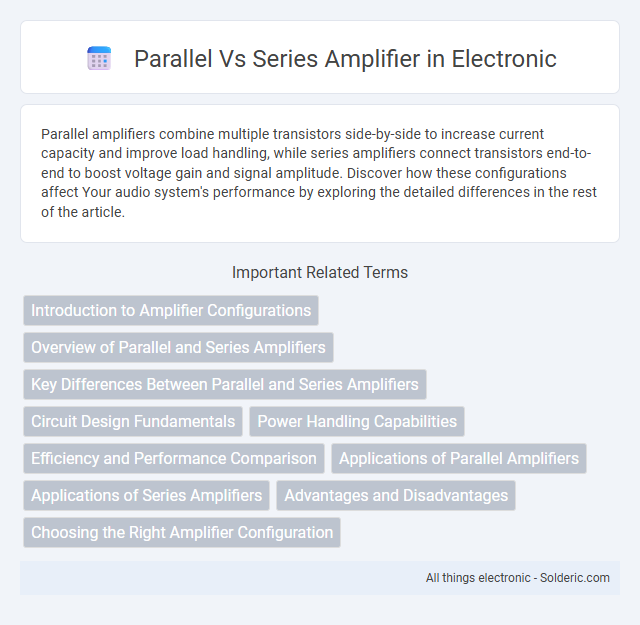Parallel amplifiers combine multiple transistors side-by-side to increase current capacity and improve load handling, while series amplifiers connect transistors end-to-end to boost voltage gain and signal amplitude. Discover how these configurations affect Your audio system's performance by exploring the detailed differences in the rest of the article.
Comparison Table
| Feature | Parallel Amplifier | Series Amplifier |
|---|---|---|
| Configuration | Multiple transistors connected in parallel | Multiple transistors connected in series |
| Output Current | Increased output current capacity | Limited by single transistor current rating |
| Output Voltage | Approximately same as individual transistor voltage | Sum of individual transistor voltages |
| Input Impedance | Lower input impedance due to parallel connection | Higher input impedance due to series connection |
| Power Dissipation | Spread across devices, better thermal management | Concentrated, potential thermal hot spots |
| Complexity | Moderate complexity in current sharing | Higher complexity in voltage balancing |
| Applications | Used where high current output is needed | Used where high voltage gain is required |
Introduction to Amplifier Configurations
Amplifier configurations primarily include parallel and series setups, each influencing signal amplification and power distribution differently. Parallel amplifiers combine multiple amplifier outputs to increase current capacity while maintaining voltage, ideal for driving low-impedance loads. Series amplifiers, also known as cascaded amplifiers, connect stages sequentially to boost voltage gain, enhancing signal strength for sensitive or high-impedance applications.
Overview of Parallel and Series Amplifiers
Parallel amplifiers combine multiple transistors or components side-by-side, increasing current capacity without raising voltage, ideal for high-current applications with improved thermal distribution. Series amplifiers arrange components end-to-end, boosting voltage gain by the cumulative effect of each stage, making them suitable for high-voltage or voltage amplification needs. Understanding the configuration impact on voltage, current, and thermal performance is essential for selecting between parallel and series amplifier designs.
Key Differences Between Parallel and Series Amplifiers
Parallel amplifiers combine multiple amplifier outputs to increase current capacity and reduce output impedance, enhancing overall power delivery and efficiency. Series amplifiers connect amplifier stages one after another, increasing voltage gain but often resulting in higher output impedance and potential signal distortion. Your choice depends on whether you prioritize current handling and low impedance (parallel) or higher voltage amplification (series) for your application.
Circuit Design Fundamentals
Parallel vs series amplifier circuit design fundamentally differs in how transistors share load and affect performance; parallel amplifiers connect transistors side-by-side, increasing current capacity and reducing distortion by distributing the load, while series amplifiers place components end-to-end, boosting voltage but potentially increasing power dissipation and affecting stability. Understanding device parameters such as input impedance, output impedance, gain, and thermal management is crucial when designing your amplifier for optimal efficiency and sound quality. Proper layout and feedback mechanisms ensure that these design fundamentals translate into reliable, high-performance amplification.
Power Handling Capabilities
Parallel amplifiers offer higher power handling capabilities by distributing the load across multiple transistors or components, reducing individual stress and heat. Series amplifiers generally handle lower power as the current flows sequentially through each component, increasing the risk of voltage drops and heat accumulation. Understanding these differences helps you select the best amplifier configuration for high-power applications.
Efficiency and Performance Comparison
Parallel amplifiers exhibit higher current capacity by distributing the load across multiple transistors, resulting in improved efficiency and reduced heat dissipation. Series amplifiers provide better voltage gain and linearity, which enhances signal fidelity but may suffer from increased power losses and lower overall efficiency. Performance optimization depends on the application's demand for power handling versus signal accuracy, making parallel designs preferable for high-power output and series designs ideal for high-gain, low-distortion needs.
Applications of Parallel Amplifiers
Parallel amplifiers are commonly used in high-power RF and audio applications where increased output current and improved thermal management are critical. They enable devices like radio transmitters, loudspeakers, and power amplifiers to handle higher load currents without distortion or overheating. By distributing the load across multiple transistors, parallel amplifiers enhance reliability and efficiency in both communication and sound reinforcement systems.
Applications of Series Amplifiers
Series amplifiers excel in applications requiring high voltage gain and improved linearity, such as audio signal amplification and precision instrumentation. Their configuration makes them ideal for driving loads with low impedance while maintaining stability in feedback circuits. Your choice of a series amplifier is beneficial in audio systems, RF transmitters, and sensor signal conditioning where distortion minimization is critical.
Advantages and Disadvantages
Parallel amplifiers offer higher current output and improved reliability since multiple transistors share the load, reducing thermal stress and enabling better fault tolerance. Series amplifiers provide greater voltage gain and simpler circuit design but can suffer from higher power dissipation and increased distortion due to voltage drops across each stage. Your choice depends on the specific application, balancing current capacity against voltage gain requirements.
Choosing the Right Amplifier Configuration
Choosing the right amplifier configuration depends on the desired output power and load handling capabilities; parallel amplifiers increase current capacity by combining multiple transistors, making them ideal for driving low-impedance loads with higher current demands. Series amplifiers, on the other hand, increase voltage gain and output voltage swing by stacking transistor stages, suitable for applications requiring higher voltage headroom. Selecting between parallel and series designs involves balancing factors such as power efficiency, thermal management, and the specific electrical requirements of the target circuit.
Parallel vs Series amplifier Infographic

 solderic.com
solderic.com